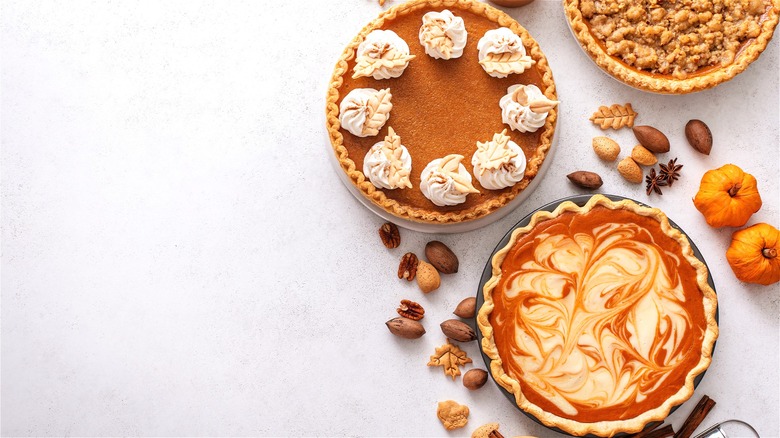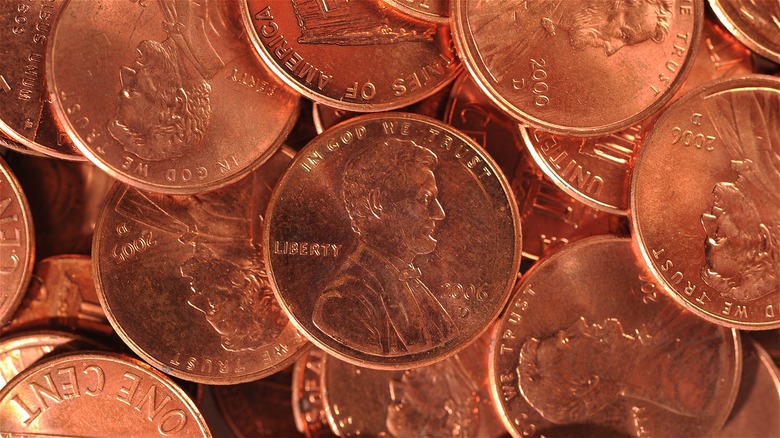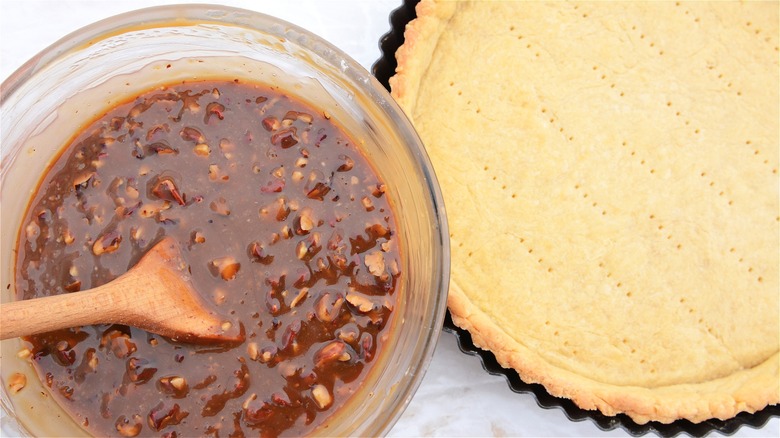The Unexpected Penny Hack That'll Save Your Thanksgiving Pie
Venturing into pie-baking during the holiday season can be stressful, even for the most experienced home chefs. Of course, you could downshift your lofty expectations and make a Thanksgiving dessert that isn't pumpkin pie. But something about the holidays beckons the enjoyment of a traditional fruit-filled or cream-based dessert, flaky crust included. To make the baking process easier, you can even use pennies as pie weights.
If you have a pie on your Thanksgiving menu that requires either a pre-made crust or a partially baked crust, you may have already read the ins and outs of blind baking. Blind baking, par-baking, or baking that tender exterior before filling may seem intimidating. But as long as you have reliable pie weights to keep that butter and flour-filled lining from puffing up in the oven, you should have a perfectly baked pie crust in no time.
To get the job done, you can splurge on some expensive metal pie weights, but for convenience purposes, why not sub in your loose change? If you've been looking to put your spare pennies to good use, metal coins work as the perfect pie filler when blind baking. Because pennies retain and transfer heat quite well, not only will your pie crust bake even faster, but you'll also have just the right amount of pressure to keep the base of your crust weighted down amidst the baking process.
How to use pennies as pie weights
Before you line your pie crust with spare coins, there's a protocol worth following anytime you use an unconventional household item as pie weights.
First, you don't need a ton of spare change to get the job done. Pennies aren't necessarily light, so aim to cover just the bottom of your pie dish evenly when blind-baking. Next, make sure to line your pie pan with a sufficient layer of aluminum foil before adding the pennies. Considering the fact that loose change has been touched by countless hands besides yours, you want to make sure any associated germs are kept away from that precious crust.
Pennies also conduct heat well so a blind-baked, coin-filled crust may not take as long in the oven versus a pie baked with alternative pie weights. Also, keep in mind that once your par-baked crust is sufficiently cooked, those included coins will remain extremely hot for a short while, which might affect the overall baking time. Due to the transmission of heat, some bakers recommend using parchment paper over foil when baking with coins.
Using pennies as pie weights saves money, not time
If you already know you're going to need to partially blind-bake homemade pumpkin pie, you might want to consider the prep work that comes with using pennies over other pie-weight substitutes. While foil or parchment paper may serve as a helpful barrier between your pie crust and pocket change, you might feel a bit uneasy placing coins that have been circulated throughout the U.S. directly into your pie pan. Despite the use of foil or parchment paper, washing the coins in hot, soapy water is also recommended.
If you don't want to go through that additional step, you can also use other common household items, such as popcorn kernels or dried beans. (Just keep in mind that once kernels and beans have been baked, they're technically unable to be prepared as food.) And if you want to throw in the towel on pantry staples, you can purchase ceramic pie-weight balls, which are one of the most affordable options available within the retail market space.
But if your main goal is to use what you have, plan ahead and carve out some time to wash your precious pennies before using them in your next blind bake. The benefit of using coins as pie weights lies in their reusability. Not only can pennies maintain the shape of your next pie crust, but they'll also help pay for the essential ingredients necessary to make your next delicious Thanksgiving dessert.


